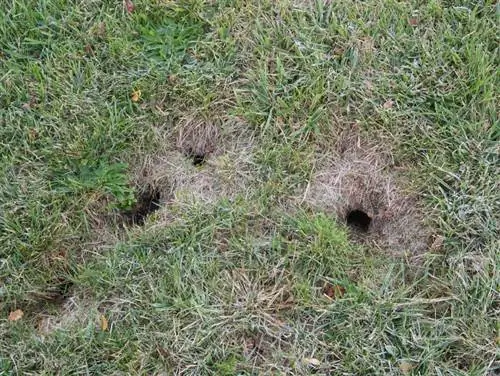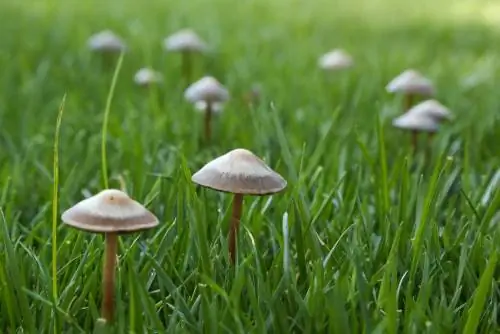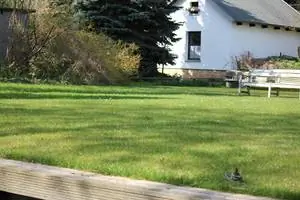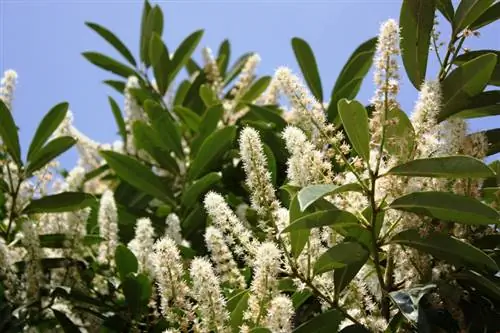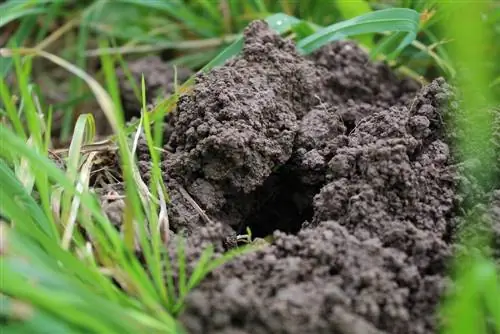- Author admin [email protected].
- Public 2023-12-16 16:46.
- Last modified 2025-06-01 06:02.
If holes turn the lawn into a crater landscape, every lawn mowing becomes a bumpy ride. The following lines reveal who caused the damage and how you defend yourself against it.

What to do about holes in the lawn?
Holes in the lawn can come from earthworms, birds, hedgehogs, mice or moles. Some holes are even beneficial for the growth of the lawn. To combat unwanted holes, acoustic deterrent methods or foul-smelling substances can be used to drive away the animals, although the mole is a protected species and should be driven away gently.
How to identify the culprit
Holes in the lawn appear at any time of the year. In order to take effective action against the perpetrators, they must be clearly identified. We list the most important clues to the usual suspects in the following overview:
- Countless small holes a few millimeters in diameter: earthworms
- Recesses of 2 centimeters size: birds or hedgehogs
- 3-5 centimeter large hollows that open into an underground passage: field mice or mice
- Holes under a mound: mole or vole
If these are superficial depressions with scratched soil around them, a badger, raccoon or fox was hunting here. This is a rare damage pattern in the lawn that usually does not repeat itself.
These holes require no defensive measures
Although they are not pretty to look at, they promote the growth and vitality of the lawn. We're talking about earthworm holes. The activities of these soil organisms make an irreplaceable contribution to the aeration of the soil and the formation of humus. The depressions of hedgehogs and birds have a similar beneficial effect. These arise because the beneficial insects are on the hunt for pests.
If the sight bothers you, rake the soil with a little compost and sprinkle lawn seeds on it. Loose pieces of grass are quickly pinned back in place.
Scare away moles and voles - this is how it works
In the eco-friendly garden, no animal visitor is sentenced to death for digging a few holes or raising a hill. Instead, moles and voles are escorted out the garden door using the following methods:
Acoustic Deterrence
- Place metal poles with T-handles into the ground, tie empty cans and let them dangle
- Position solar-powered ultrasonic fright devices (€20.00 on Amazon) at the holes
- Place bottomless glass bottles upside down in the entrances so that the wind whistles in them
Dispel with bad smells
- Put cloths soaked in vinegar essence into the holes
- Pour high-proof alcohol into the tunnels
- Soak scraps of clothing with petroleum and stuff them into the aisles
- Remove the mound and place fish heads in the depression
Butyric acid has proven to be the ultimate tool for exiling moles or voles. The nauseating-smelling liquid is available commercially and is applied to as many holes in the lawn as possible using cloth rags. Their sensitive olfactory nerves encourage the rodents to flee as quickly as possible.
Mole is under nature protection
The mole - in contrast to the vole - is protected from stalking according to the Federal Nature Conservation Act. The gifted tunnel builder may not be hunted, captured or killed. Only gentle expulsion from the garden is tolerated.
Tips & Tricks
Did you know? The soil from a molehill tops any commercially available potting soil. The cute fur ball's small hand shovels carefully sift the earth and loosen it thoroughly. In addition, the substrate is rich in nutrients and humus, ideal for the magnificent growth of your potted plants.

